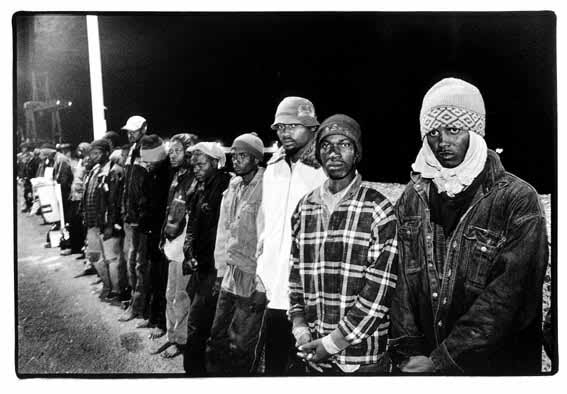
Droomeiland Fuerteventura

![]() De nieuwe route naar Europa voor Afrikaanse vluchtelingen, asielzoekers en emigranten gaat via de Canarische Eilanden.
Dagelijks komen er kleine bootjes aan op het eiland Fuerteventura, meer dan honderd kilometer van het Afrikaanse vasteland.
De nieuwe route naar Europa voor Afrikaanse vluchtelingen, asielzoekers en emigranten gaat via de Canarische Eilanden.
Dagelijks komen er kleine bootjes aan op het eiland Fuerteventura, meer dan honderd kilometer van het Afrikaanse vasteland.
Marokaanse mensensmokkelaars verdienen tienduizend Euro per trip. Voor dat geld droppen ze 15 tot 20 Afrikanen op de stranden van het Spaanse eiland.
De transporten vertrekken vanuit de Spaanse Sahara, door Marroko geanexeerd grondgebied, aan de Atlantische Oceaan. Na een reis van twintig uur bereikt een onbekend aantal bootje ongezien de kust. Sommigen keren om, anderen worden, ontdaan van de buitenboordmotor op het strand achtergelaten.
De Guardia Civil onderschept op volle zee dagelijks een of twee van deze "patera's", kleine houten bootjes volgeladen met Afrikanen. De meesten van hen komen uit Marroko, Algerije, Ghana, Siera Leone en Mali.
Families en alleen reizende minderjarigen worden opgevangen in twee centra van het Spaanse Rode Kruis. De rest wordt overgedragen aan de Policia National, die sluit ze op in een gebouw van het vroegere vliegveld van Fuerteventura.
Volgends de Spaanse wet mogen arrestanten, die geen ander delict hebben begaan dan geen papieren hebben, maximaal 40 dagen worden opgesloten. Omdat de autoriteiten ze niet willen vrijlaten op het kleine Fuerteventura worden ze verscheept naar het grotere Gran Canaria, daar worden ze in de hoofdstad Las Palmas aan hun lot overgelaten.
Hier hebben de Afrikanen geen enkele vorm van inkomen. Ze kunnen niet per boot of vliegtuig naar het Spaanse vasteland reizen omdat ze daarvoor de vereiste papieren niet hebben. Veel vrouwen komen in Las Palmas in de prostitutie terecht. De mannen hangen rond in de stad. Ze slapen op straat en in portiekenen ze wassen zichzelf op de stranden s'morgens vroeg vůůr de toeristen arriveren.

![]() The new route to Europe for African refugees, asylum seekers and emigrants, is via the Canary Islands.
They arrive daily in small boats on the island of Fuertaventura, a distance of some hundred kilometers from the African mainland.
Moroccan peoplesmugglers make ten thousand Euroís per trip. For that money they put fifteen to twenty Africans on the beaches of
this Spanish island.
The new route to Europe for African refugees, asylum seekers and emigrants, is via the Canary Islands.
They arrive daily in small boats on the island of Fuertaventura, a distance of some hundred kilometers from the African mainland.
Moroccan peoplesmugglers make ten thousand Euroís per trip. For that money they put fifteen to twenty Africans on the beaches of
this Spanish island.
The transports leave from Spanish Sahara, a territory annexed by Morocco, on the Atlantic Ocean. After a twenty hour voyage an unknown number of boats reach the beaches unseen. Some of them return, others are stripped of their outboard motors and left on the beach.
The Guardia Civil intercepts every day, in open seas, one or two of these pateraís small wooden vessels overloaded with Africans. Most of them originate from Morocco, Algeria, Ghana, Sierre Leone, Cameroon and Mali.Those who succeed in landing unseen on Fuerteventura, try to proceed to the Spanish mainland, but this is very difficult as most of them donít possess any papers. Many of them get rounded up roaming the island. Families with children and unaccompanied minors are accommodated in the relief centres of the Spanish Red Cross. The others are handed over to the Policia Nacional, who lock them up in buildings that form part of the old airfield of Fuerteventura.
According to Spanish law people who have committed no other offence than entering the country
without valid papers, have to be released after forty days.
Because the authorities donít want to do that on the small island of Fuertaventura,
they are shipped to the largest Canary island - Gran Canary. There, in the capital Las Palmas,
they are left to their own devices.
Here the Africans have no form of income whatsoever. They canít travel by ferry or airplane to the Spanish mainland, because they donít have the necessary papers. Many women end up prostituting themselves in Las Palmas. The men hang around in the city. They sleep on the street and on porches and they wash themselves early in the morning on the beaches, before the tourists arrive.
© 2002 Piet den Blanken.